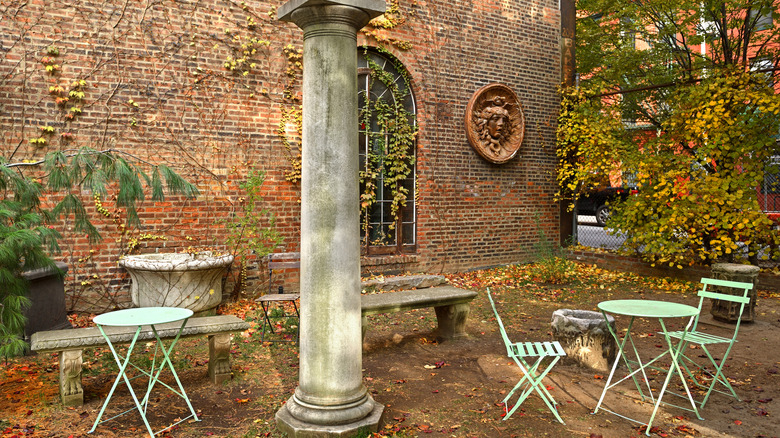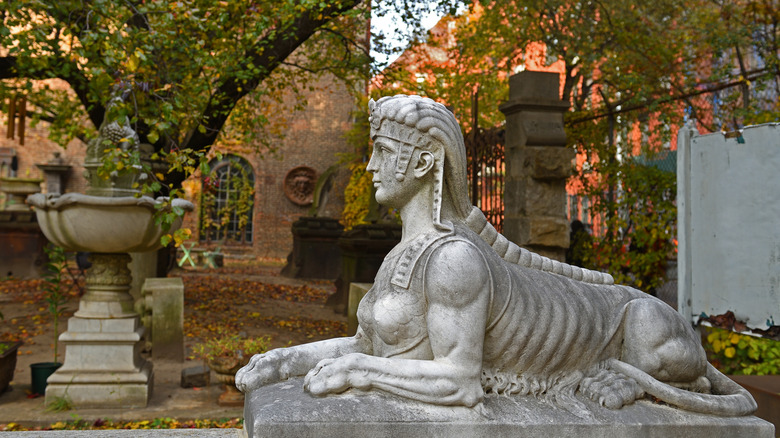New York City's Secret Garden Full Of Sculptures And Flowers That Locals Hope To Keep Faces Possible Demolition
Green space in New York City is precious and strongly protected by the communities that rely on it as an escape from the concrete jungle. That's largely because it's hard to come by, particularly in the densely packed, tenement-lined Lower Manhattan. Sure, there are a few big parks around the city, but many of them — like its largest, the wildly underrated Pelham Bay Park on the Bronx's coast — lie in the outer boroughs. In Manhattan, finding a sliver of nature often means looking into tucked-away courtyards or even above the street, as in the case of the Elevated Acre, a secret garden hiding in plain sight. But there's one green space that many New Yorkers know and love, located right at the center of the shop-filled Nolita neighborhood: Elizabeth Street Garden. This pretty oasis between high rises is a city gem, but it may soon be razed for development.
In 2023, after about a decade of head-to-head between the garden's advocates and housing developers, a New York court ruled in favor of replacing the garden with affordable housing. Proponents of the plan cite New York's housing shortage, particularly for lower-income residents. Opponents, including the nonprofit that manages and maintains Elizabeth Street Garden, argue that there are several other properties in the same district suitable for development that wouldn't require destroying the garden. In either case, while a fleet of back-and-forth arguments tentatively keeps the garden in place, it's a lovely space to visit. Admire its sculptures, have a picnic among the flowers, or attend some of its free, public events while you still can.
The history and dilemma of Elizabeth Street Garden
Located at the junction of New York City's Little Italy and SoHo neighborhoods, Elizabeth Street Garden is the only public green space in the area, and it has served the public since 1822. Originally purchased by the Free School Society, the site once spanned three lots (today, only one remains undeveloped). After cycling through several public schools that used the space for recreation and meetings, the buildings were eventually demolished, and the lot became overgrown and vacant. The city leased the space to Allan Reiver, owner of Elizabeth Street Gallery, in 1991, and Reiver turned it into a beautifully landscaped sculpture garden.
Reiver's garden remained open to the public without conflict until 2012, when the city included it in a development plan for urban renewal. The project, known as Haven Green, would build over the space with a mix of offices, luxury retail, and affordable housing. It would also add 123 apartments for low-income seniors. New York City housing commissioner Adolfo Carrión Jr., a supporter of the project, told The New York Times, "The fight over this land highlights how difficult it can be to build affordable housing, especially in neighborhoods that offer strong economic opportunities."
Still, the garden's defenders argue that removing it comes with a significant cost. "The sense of community in many neighborhoods is dwindling and diminishing, so having [the garden] acts as a lifeline," said Joseph Reiver, Allan Reiver's son, in The Architect's Newspaper. "The city would be hurting itself by getting rid of something that's a vital part of the community."
Stroll among Elizabeth Street Garden's statues while you still can
Despite a 2023 court ruling in favor of developing the site, the future of Elizabeth Street Garden is still somewhat up in the air. Though the city could have begun construction as early as March 2025, the garden remains open to the public as of this writing, and, as reported by The New York Times, the city may be reconsidering the development plan.
For now, visitors can enjoy the cultivated flora and collected artwork that color the lot. Neoclassical sculptures Allan Reiver's collection are tucked among flower beds and fruit trees. Look for the statue of a Greek goddess holding grapes or a replica of the Greco-Roman sculpture "Boy with Thorn." Also take note of the garden's iron gazebo: It was designed by the Olmsted Brothers in 1898 for a Long Island mansion.
Time your visit right, and you might be lucky enough to catch a free performance or reading. Many of its events have been hosted to support the garden's continuance — like the April 2025 performance of Patti Smith, who appeared to show her support. The garden is just a few minutes' walk from Spring Street station, served by the 6 Train. It's about a 20-minute ride from Grand Central Station or roughly an hour from LaGuardia Airport. While you're in the neighborhood, walk about 5 to 10 minutes south to Grand Street, and you'll get to one of America's best Little Italys.


